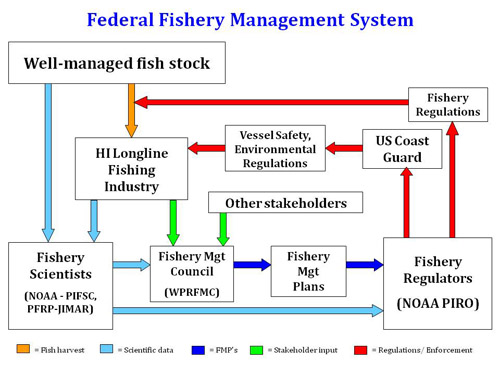Fishery Improvement Process (FIP) for the Management of US Pelagic Fisheries of the Western Pacific Region

EXECUTIVE SUMMARY
Sustainable fisheries are those that operate under a science-based adaptive management approach, with sustainable fish population and harvest targets and controls ecosystem impacts. Effective management systems are designed to develop and adapt regulations to changing scientific understanding and conditions through a transparent process with public input. Well-managed fisheries must have a built-in Fishery Improvement Process (FIP) of regular re-assessment and a demonstrated track record of fishery improvements in understanding and management of fishery impacts. Sustaining fisheries requires an ongoing process of continual improvements. Each fishery can be evaluated based on how effective and evolved the fishery management framework is in being capable of and committed to continual improvement in sustainable fisheries management.
There is a Fishery Improvement Process inherent in the federal management system under the US National Oceanic and Atmospheric Administration (NOAA) and the Western Pacific Regional Fishery Management Council process for the US pelagic fisheries in the Western Pacific Region including Hawaii, American Samoa, Guam and the Commonwealth of the Northern Mariana Islands. The continual Fishery Improvement Process is highly-evolved, well-documented and has resulted in a model for sustainable pelagic fisheries management.
Sustainable fisheries are not zero impact fishing activities on virgin fish populations and without adverse impacts on the environment. No food production system is without adverse environmental impacts. The term fishery assumes and includes a human component. Wild capture fisheries are vital to the production of food, income and employment, especially in coastal communities. As fishing technology and ability to locate and harvest fish has evolved, so has the need for science-based management of fisheries and their sustainable harvest over the long-term. It should be recognized that fishery managers manage people, their activities and impacts on the fish stocks and ecosystem. Managers also depend on data collected from fishing activities for the science needed for effective management of responsible and sustainable fisheries.
Truly sustainable fisheries operate under a Fishery Management Plan (FMP) that; 1) is science-based; 2) applies the precautionary principle; 3) has adopted the ecosystem-approach to management; and 4) has established fish catch and population targets which allow for sustainable harvest year after year without jeopardizing the wild seafood production for future generations. The Fishery Management Plan and framework must; 1) produce an adequate quantity and quality of fishery dependent and independent data; 2) perform rigorous and timely analysis of those data and make continual efforts to improve the scientific understanding of fisheries; 3) have the ability to control catch within sustainable limits; and 4) reevaluate and adjust management measures in a transparent process with diverse stakeholder and scientific input to address changing conditions to keep the fishery operating sustainably. Effective fishery management not only needs adaptive rule making, but also good governance including effective monitoring and enforcement. For these reasons, the evaluation of the management system of fisheries is essential to determining whether a fishery is well-managed, has the capabilities needed for sustainable fisheries development and management and has a demonstrated track record of continual improvement in its 1) science-based fishery management system, 2) the impacts on harvested fish stocks and 3) control of ecosystem impacts.
The US pelagic fisheries of Hawaii, American Samoa, Guam and the Commonwealth of the Northern Mariana Islands are managed under a highly-evolved Fishery Ecosystem Plan (FEP) and fishery management framework that has a long track record that demonstrates the commitment to sustainable fishery management. Imbedded in the management system is a continual Fishery Improvement Process that has resulted in one of the world’s most intensively studied, monitored and responsible pelagic fisheries. Publicly available information will be used to document the track record and ongoing process of continual fishery improvement in the US pelagic fisheries of the Western Pacific that operate under the Fishery Ecosystem Plan and to demonstrate why its seafood products are sustainable.

